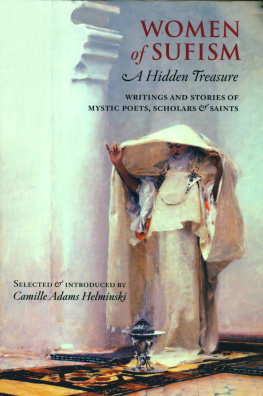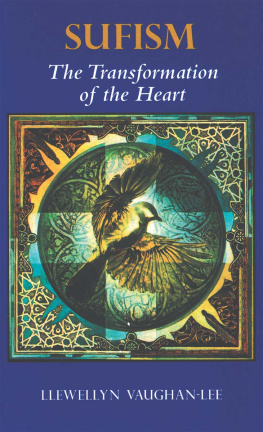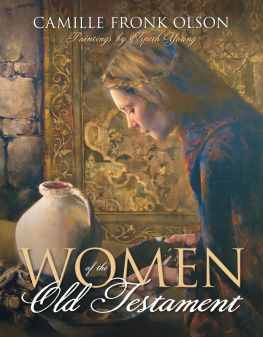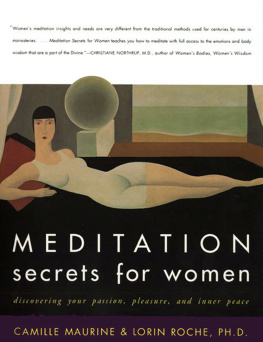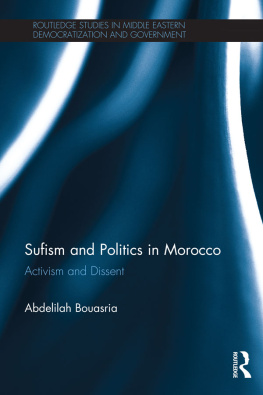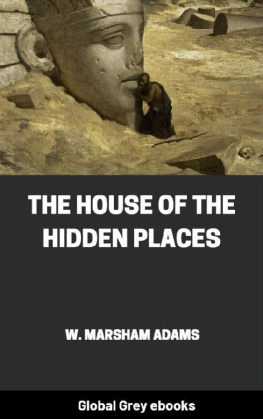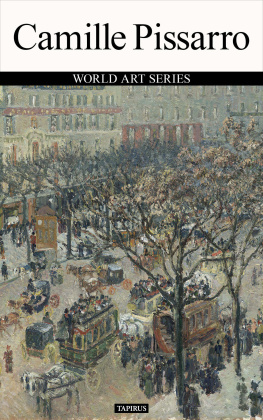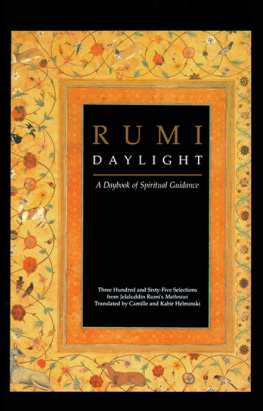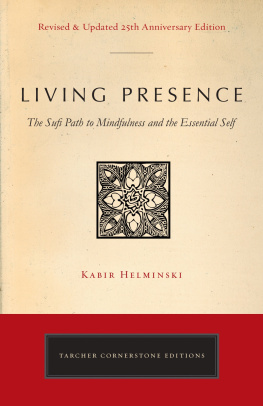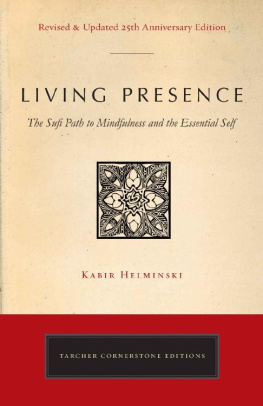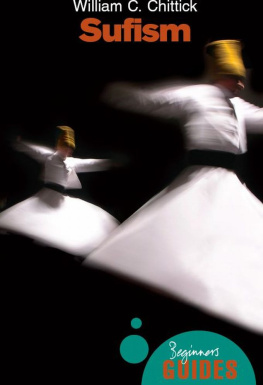Camille Adams Helminski - Women of Sufism: A Hidden Treasure
Here you can read online Camille Adams Helminski - Women of Sufism: A Hidden Treasure full text of the book (entire story) in english for free. Download pdf and epub, get meaning, cover and reviews about this ebook. year: 0, publisher: Shambhala, genre: Religion. Description of the work, (preface) as well as reviews are available. Best literature library LitArk.com created for fans of good reading and offers a wide selection of genres:
Romance novel
Science fiction
Adventure
Detective
Science
History
Home and family
Prose
Art
Politics
Computer
Non-fiction
Religion
Business
Children
Humor
Choose a favorite category and find really read worthwhile books. Enjoy immersion in the world of imagination, feel the emotions of the characters or learn something new for yourself, make an fascinating discovery.
- Book:Women of Sufism: A Hidden Treasure
- Author:
- Publisher:Shambhala
- Genre:
- Year:0
- Rating:3 / 5
- Favourites:Add to favourites
- Your mark:
- 60
- 1
- 2
- 3
- 4
- 5
Women of Sufism: A Hidden Treasure: summary, description and annotation
We offer to read an annotation, description, summary or preface (depends on what the author of the book "Women of Sufism: A Hidden Treasure" wrote himself). If you haven't found the necessary information about the book — write in the comments, we will try to find it.
Women of Sufism: A Hidden Treasure — read online for free the complete book (whole text) full work
Below is the text of the book, divided by pages. System saving the place of the last page read, allows you to conveniently read the book "Women of Sufism: A Hidden Treasure" online for free, without having to search again every time where you left off. Put a bookmark, and you can go to the page where you finished reading at any time.
Font size:
Interval:
Bookmark:

Women of Sufism is a valuable addition to Sufi literature and womens spiritual studies. Camille Helminski awakens us to the important contribution of women to this mystical tradition.
Llewellyn Vaughan-Lee, PhD, author of Sufism: The Transformation of the Heart
ABOUT THE BOOK
The luminous presence of women who follow the Suf Waythe mystical path of Islamis brought to life here through their sacred songs and poetry, their dreams and visions, and stories of their efforts as they witness the Truth in many realms. These writings reflect the honor and respect for the feminine in the Sufi worldview, and they are shared in the spirit of inspiration and hope for the flourishing contributions of women to the spiritual development of humanity.
Spanning the centuries, from the time of the Prophet Muhammad to the present day, the selections are by or about an array of Sufi traditions in different parts of the world, from Asia, Africa, and the Middle East to Europe and Americafrom beloved members of the Prophets family to the mystic Rabia al-Adawiyya to the modern scholar Annemarie Schimmel. Biographical anecdotes and personal memoirs provide a glimpse into the experiences of great saints and contemporary practitioners alike, while providing an introduction to the principles and practices of Sufism.
CAMILLE ADAMS HELMINSKI is cofounder and codirector of the Threshold Society in Aptos, California, an educational foundation in the Mevlevi tradition based on the teachings of Rumi. She was the first woman to translate a substantial portion of the Quran into English, in her book The Light of Dawn. Among her other translations are The Mevlevi Wird: The Prayers Recited Daily by Mevlevi Dervishes; Rumi Daylight and Jewels of Remembrance (with Kabir Helminski); and Awakened Dreams and Mevlevi Ayins (with Refik Algan).
Sign up to receive news and special offers from Shambhala Publications.

Or visit us online to sign up at shambhala.com/eshambhala.
Shambhala Publications, Inc.
Horticultural Hall
300 Massachusetts Avenue
Boston, Massachusetts 02115
www.shambhala.com
2003 by Camille Adams Helminski
All rights reserved. No part of this book may be reproduced in any form or by any means, electronic or mechanical, including photocopying, recording, or by any information storage and retrieval system, without permission in writing from the publisher.
Chapter heading ornaments courtesy of Gulben Efe
Designed by Lora Zorian
LIBRARY OF CONGRESS CATALOGING-IN-PUBLICATION DATA
Women of Sufism: a hidden treasure/selected and edited by Camille Adams Helminski
p. cm.
Includes bibliographical references.
eISBN 978-0-8348-2830-8
ISBN 978-1-57062-967-9
1. SufisBiography. 2. Muslim womenBiography. I. Helminski, Camille Adams, 1951
BP189.4 .W66 2003
297.40922dc21
2002008067

DEDICATED
To my sisters in spirit and in blood,
Marian and Anne, my mother, Mimi,
and the mothers, sisters, and friends
who preceded us and those who accompany us,
to my Godmothers, Carolyn Fox and Dolly Ann Tyler
and her daughter Connie,
to my daughter, Carolyn Grace;
and my nieces, Mira and Usha,
to my Goddaughter Alex and her sisters Tyler and Ashley,
and the many daughters and friends who will follow us,
to those mentioned here and those who remain nameless
who carried the Light of Divine Presence
and will continue to carry it,
to those who stand witness at the Threshold of both worlds
that in the end are One
in acknowledgment of the infinitude of sustenance that comes
from our Most Generous and Gracious Sustainer.
Whenever Zachariah visited her in the sanctuary,
he found her provided with food. He would ask,
O Mary, from where did this come to you?
She would answer: It is from God;
see how God grants sustenance to whom He/She wills,
beyond all reckoning.
QURAN, SURAH IMRAN 3:37
Contents
This book contains diacritics and special characters. If you encounter difficulty displaying these characters, please set your e-reader device to publisher defaults (if available) or to an alternate font.
I was a Hidden Treasure and I loved to be known,
so I created the two worlds in order that My treasure
of lovingkindness and generosity might be known.
HADITH QUDSI
M ANY YEARS AGO, the impulse arose to gather material about women who have followed the Way of Sufism, the mystical heart of Islam. Being a woman on the Sufi Path myself, I had become aware of how little was available either in current example or in historical notation about women who had matured in this Way. The search began, to understand more myself, and to discover stories of women that could be shared. Since that first impulse, eighteen years ago now, much has unfolded. Manuscripts once thought lost, such as as-Sulamis biography of Sufi women, have resurfaced and in recent years new research has also been made available. The pile in my study of references, stories, and writings of experience of women on this Way has grown over the years, until now the moment of birthing of this book has arrived with the gracious help of Our Most Generous Sustainer, and of many women and men for whose efforts in sharing these stories and excerpts I am most grateful. Due to space limitations it was not possible to include all that might be included; this volume is just a small offering in respect of all those strong women of Spirit of the Sufi Path who have come before us and all those who continue with us and all those who will, with Gods grace, follow after us. May God forgive me for whatever mistakes I have made in this humble attempt.
The selections have been ordered in a roughly chronological manner but also thematically. The first section relates the stories of three women who might be referred to as the first Sufi womenKhadija, Fatima, and Aishaall luminous women of the family circle of the Prophet Muhammad, may peace and blessings be with them all. The second section relates the stories of some of the Sufi women of the early centuries of Islam when the world of Sufism flourished mainly in what we now refer to as the Middle East and adjacent regions. The third section relates the stories, knowledge, and experience of women in Sufism throughout the remaining centuries up to this present moment, from many regions of the world where Sufism has spread, representing many of the predominant Sufi orders that have developed. Our aim has been to share the vast and varied treasure of womens experience and contribution in the world of Sufism, this treasure that has been for so long relatively hidden. And in the sharing, it was my hope also to open to the understanding of the reader the essential perspectives, principles, and practices of the Way that is Sufism. As it is recited repeatedly in all moments of life, Bismillah ar-Rahman ar-Rahim, we begin in the Name of God.
When referring to God in the text, in some cases I have used both the feminine pronoun and the masculine so that those reading this book may be reminded that within the universe and understanding of the Quran, the sacred text of Islam, God is without gender. I also occasionally use both in reference to the human being as well, so that we may be reminded that humanity and its evolving experience is, naturally, inclusive of both genders. Truly, Our Sustainer is beyond anything by which we may seek to define Him/Her (Surah as-Saffat 37:180). The Quran is one of the few Holy Books with which I am familiar that speaks directly to both men who have faith and women who have faith in numerous passages. In fact, the number of times that men and women are mentioned is equal. It is understood that in Gods sight, men and women are equal; what matters is not gender, wealth, or power, but that we bring to our Sustainer a sound heart (Surah ash-Shuara 26:89) when we return to Our Source. It is these who shall find themselves abiding in the Garden, now and eternally... a Garden underneath which rivers flow, and where everywhere one is met with the greeting, Peace (Surah Ya Sin 36:58).
Font size:
Interval:
Bookmark:
Similar books «Women of Sufism: A Hidden Treasure»
Look at similar books to Women of Sufism: A Hidden Treasure. We have selected literature similar in name and meaning in the hope of providing readers with more options to find new, interesting, not yet read works.
Discussion, reviews of the book Women of Sufism: A Hidden Treasure and just readers' own opinions. Leave your comments, write what you think about the work, its meaning or the main characters. Specify what exactly you liked and what you didn't like, and why you think so.

